

OpenLDAP Access Control. 8.1.

Introduction As the directory gets populated with more and more data of varying sensitivity, controlling the kinds of access granted to the directory becomes more and more critical. For instance, the directory may contain data of a confidential nature that you may need to protect by contract or by law. Or, if using the directory to control access to other services, inappropriate access to the directory may create avenues of attack to your sites security that result in devastating damage to your assets. Access to your directory can be configured via two methods, the first using The slapd Configuration File and the second using the slapd-config(5) format (Configuring slapd). The default access control policy is allow read by all clients. As a consequence, it's useless (and results in a performance penalty) to explicitly list the rootdn among the <by> clauses.
The following sections will describe Access Control Lists in greater depth and follow with some examples and recommendations. Creating SHA and SSHA passwords. Sets in access controls. This is an elaboration on the message originally written by Mark Valence describing his set syntax.
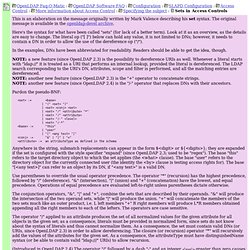
The original message is available in the openldap-devel archive. Here's the syntax for what have been called "sets" (for lack of a better term). Look at it as an overview, as the details are easy to change. The literal op ("[ ]") below can hold any value, it is not limited to DNs; however, it needs to contain a DN in order to allow the use of the dereference op ("/"). In the examples, DNs have been abbreviated for readability. Re: How to disable or enable an ldap user account. [Date Prev][Date Next] [Chronological][Thread][Top] On Tuesday 21 October 2008 15:39:25 Almir Karic wrote: > On Mon, Oct 20, 2008 at 4:37 PM, Bill Jorgensen > ><Bill.Jorgensen@eim-usa.com> wrote: > > I would need a little more information to help you.

I have been working > > LDAP within AIX so I know that pretty well... > > what i'd like to know is how to disable an account so you can't bind > as disabled user, while if i change my mind you can still bind as that > user (with the old password). any hints? LDAP Guide - BDB/HDB Database Caching. We all know what caching is, don't we?
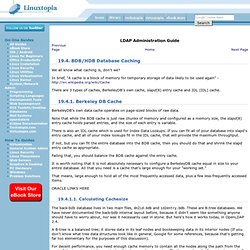
In brief, "A cache is a block of memory for temporary storage of data likely to be used again" - There are 3 types of caches, BerkeleyDB's own cache, slapd(8) entry cache and (IDL) cache. 19.4.1. Berkeley DB Cache BerkeleyDB's own data cache operates on page-sized blocks of raw data. Note that while the cache is just raw chunks of memory and configured as a memory size, the slapd(8) entry cache holds parsed entries, and the size of each entry is variable.
Dn-based linux groups from ldap. LDAP for rocket scientists. Appendix A: LDAP - Data Types. LDAP supports a sub-set (a pretty chunky sub-set) of the X.500 data types.
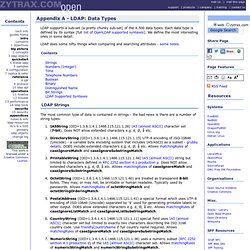
Each data type is defined by its syntax (full list of OpenLDAP supported syntaxes). We define the most interesting ones in some detail. LDAP does some nifty things when comparing and searching attributes - some notes. Contents. Schemas, ObjectClasses & Attributes. This Chapter is not for the faint-hearted.

It starts to drill down into the nauseous detail. You can either read it now or go to the Samples section and 'do stuff'. The samples have tons of links back to this chapter to explain specific items in detail. LDAP and X.500 are feet deep in terminology. Some terminology is important, some is just fluff. We have created a glossary to jog your memory and introduce terms, either because they are important or because they are frequently used in the literature. Because Schemas, objectClasses and Attributes are so interrelated, we use the highly technical term stuff to describe them collectively.
Appendix A: LDAP: Text Search Filter. The text form of the search filter is defined by RFC 4515 with a bit of help from RFC 4510 and was significantly extended with component matching (RFC3687) and Generic String Encoding Rules (GSER) (RFC4972).
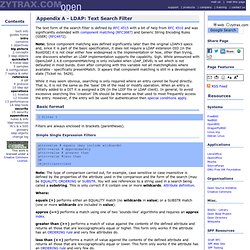
Note: Since component matching was defined significantly later than the original LDAPv3 specs and, since it is part of the basic specification, it does not require a LDAP extension OID (in the RootDSE) it is not clear either how widespread is the implementation or how, other than trying, one discovers whether an LDAP implementation supports the capability. Slapd.overlays(5. Name slapd.overlays - overlays for slapd, the stand-alone LDAP daemon Description The slapd(8) daemon can use a variety of different overlays to alter or extend the normal behavior of a database backend.
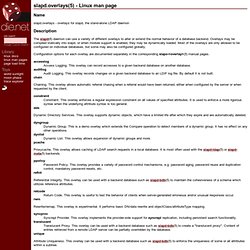
Overlays may be compiled statically into slapd, or when module support is enabled, they may be dynamically loaded. Most of the overlays are only allowed to be configured on individual databases, but some may also be configured globally. Configuration options for each overlay are documented separately in the corresponding slapo-<overlay>(5) manual pages. SSH public keys in LDAP. Description The lpk patch allows you to lookup ssh public keys over LDAP helping central authentication of multiple servers.

This patch is an alternative to other authentication system working in a similar way (Kerberos, SecurID, etc...), except the fact that it's based on OpenSSH and its public key code. We are currently working on phasing out the old code and providing an abstraction layer for publick key lookup that would move LDAP code out of OpenSSH and provide a Nice and Clean abstraction layer that allows any kind of plugins to look up the key. The original openssh-lpk project (once hosted at the OpenDarwin project) was originally created by Eric Auge was maintained by Eric Auge and Andrea Barisani. InversePath is now leaving from the development of the LDAP Public Key. Documentation. Access Control using LDAP-backed NIS Netgroups. From Port389 System Access Control using LDAP backed NIS Netgroups by Dan Cox There are many ways to control both login and service level authentication with Fedora Directory Server.
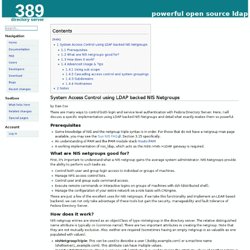
Here, I will discuss a specific implementation using LDAP backed NIS Netgroups and detail what exactly makes them so powerful. Prerequisites Some knowledge of NIS and the netgroup triple syntax is in order. An understanding of PAM and the PAM module stack Howto:PAM. SUMMARY: LDAP authentication using netgroups. Sudoers LDAP Manual. In addition to the standard sudoers file, sudo may be configured via LDAP. This can be especially useful for synchronizing sudoers in a large, distributed environment.
Rfc4512 - LDAP Directory Information Models. RFC 2798 - inetOrgPerson. Request form for OIDs. Private Enterprise OID list. Crowd - SSO and User Mgmt. PhpLDAPadmin. LDAP schema design. OpenLDAP Admin Guide. Faq-O-Matic: Passwords. Custom OpenLDAP Schemas. By Ron Peterson Editor's Note As Ron notes in his article, the adoption of LDAP has been rather slow despite its broad range of benefits; in my experience as a consultant, much of the problem stems from lack of general familiarity with the protocol, or even awareness of its existence.
To be fair, today's endless alphabet soup of protocols is enough to bewilder and stump anyone - so it's unsurprising that something this useful can get lost in the noise. However, if you need an organization-wide authentication system, or a secure, highly-scalable "White Pages" service for your company - i.e., the ability to browse directories of structured shareable information (user names, contact info, e-mail addresses, security certificates, etc.) - then LDAP is custom-made for you, and Ron's introduction just might make your initial adaptation a bit easier. Enjoy. -- Ben Okopnik Introduction. Extending LDAP schema. This chapter describes how to extend the user schema used by slapd(8). The chapter assumes the reader is familiar with the / information model. The first section, Distributed Schema Files details optional schema definitions provided in the distribution and where to obtain other definitions.
The second section, Extending Schema, details how to define new schema items. Ordered Entries and Values in LDAP. Software 2.4 Administrator's Guide: Overlays. Overlays are software components that provide hooks to functions analogous to those provided by backends, which can be stacked on top of the backend calls and as callbacks on top of backend responses to alter their behavior.